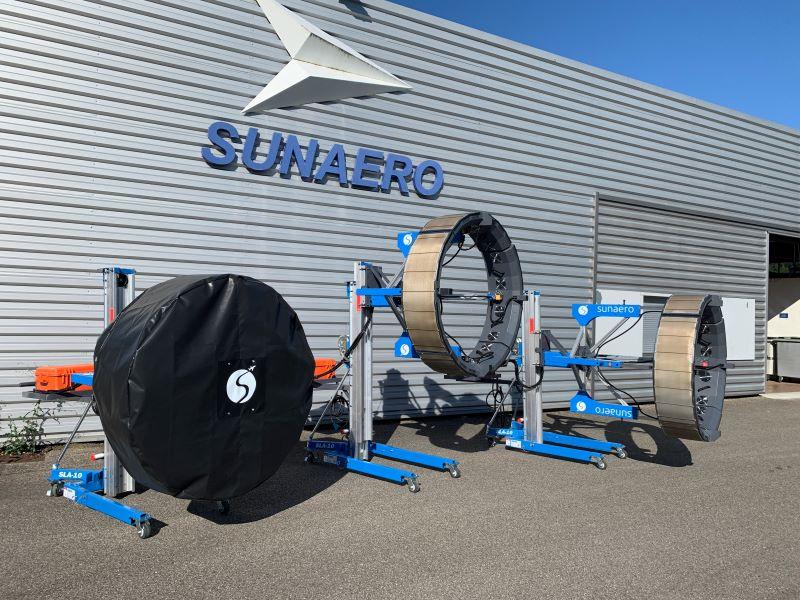
Sunaero, a Lyon-based company with expertise in fuel leak detection and fast curing for sealant repair, is proceeding with a strategy of diversification.
The company is offering complete services, from characterizing a leak to repairing every metal or composite defect in the same confined area. Additionally, Sunaero has started to offer its technologies on production lines for faster end-of-line corrections.
The masterplan is a way for an MRO company to have the edge over its competitors to meet the carriers’ need for minimum aircraft downtime. It may also signal an original trend to find customers on the manufacturing side, helping OEMs reduce delivery delays amid a challenging production ramp-up.
Sunaero’s core skills can be found in leak sensing and treatment. “When evidence of a leak is found around a fuel tank, we start with locating the origin of the leak,” Sunaero President Jean Roussel says. “It can be meters away from the evidence found on the exterior of the airframe. Filling the tank with a mix of air and helium, we use helium as a tracer gas. Helium cannot be found in ambient air, so if we detect helium, it indicates the location of the leak.”
Helium is a small molecule, so it can pass through any tiny hole. It addition, it is sticky, meaning it creates a small cloud—about 30 cm (12 in.) in diameter—around the hole it came through. It makes it easier to detect.
After the small helium cloud is found, the damaged sealing (which caused the leak) is removed. “We then apply new sealing and cure it with our Atex curing process,” Roussel says. “Our portable infrared emitters feature a large spectrum, which enables in-depth, fast curing.”
After the repair, the fuel tank is filled again with a mix of air and helium. “We use our detection system again to ensure we find no helium around,” Roussel says. “That confirms the repair was effective. The conventional repair validation method relies on filling the tank with fuel. If the repair proves ineffective and another leak detection process is needed, you have to empty the tank and ventilate it. Filling it with a mix of air and helium is much more straightforward.”
Sunaero has transitioned from a business model where it was selling repair equipment to being a repair service provider. The idea is to ensure more regular revenues. Along the same lines, the fast-curing technology has also been applied to engine abradable curing.
“We have integrated skills from companies we took over,” Roussel adds. “We can now repair metal and composite-material structures. Typically, when our technicians repair fuel tanks, they may spot another problem. We can now follow up and offer a repair.”
Sunaero took over Clermont-Ferrand-based ASA for its know-how in on-wing repairs and as a repair station. Non-destructive testing capabilities are being added to characterize the damage in a material.
Sunaero’s repair techniques can be repurposed to production line applications. “At the end of a final assembly line, small defects in seals or paint sometimes have to be corrected,” Roussel says. “That is where we come into play. Our curing method is much faster than the conventional one—typically eight hours versus 72 hr. Therefore, end-of-line corrections no longer hold the entire process. We provide Airbus with such services on final assembly lines.”
Thanks to growing demand in MRO and production, as well as acquisitions, Roussel hopes to double the company’s revenues to €25 million ($27 million) in three years. “That will help us have fully fledged human resources and cyber security departments,” he says. Sunaero’s personnel headcount stands at 70, including 30 in Lyon and 10 at each of three sites in Johor, Malaysia; Nashville, Tennessee; and Paris.
Roussel has further ideas, especially to support aviation’s decarbonization effort. “In the future, we may offer hydrogen detection,” he says. “The challenge lies in accurately locating the leak. Hydrogen is so volatile that you have to take the sensor to only centimeters of the leak to detect it.”
In its crosshairs, Sunaero also has a company with the capability to detect damage on an electric wire. Accuracy stands at 10 cm. “That will become even more valuable if future aircraft resort to electric propulsion,” Roussel says. “We are considering acquiring that company.”
“When we entered the COVID crisis, we were in a sound financial situation,” he says. “We were gearing up for external growth. We were ready to present a healthy balance sheet to lenders.” The external growth project was only postponed.
Another idea is to have employees based at the customer’s maintenance facilities. “When they open a fuel tank for some other operation, we could take that opportunity and perform preventive tests,” Roussel says. “The customer would pay a regular fee, instead of having to pay for an expensive repair when a problem arises.”
Inside Sunaero’s facilities, a research and technology project is ongoing. The goal is to accelerate the ventilation of a fuel tank, making it possible for a human to work in a fuel tank sooner after emptying it.
“Currently, draining the tank and ventilating it takes 24-48 hr.,” Roussel says. “We are aiming for two hr. The system will then monitor vapors, to guarantee safety.” The project is funded by the defense innovation agency.
Another application could be studying the diffusion of helium in fuel tanks, when a Sunaero technician fill them with the air and helium mix. The company might thus find a way to use less helium.





